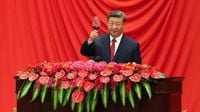The global contest over critical minerals and the technology to process them has entered a fever pitch, with the past week delivering a barrage of policy moves, market shocks, and diplomatic maneuvers from Washington to Beijing. What began as a trade spat over tariffs has now escalated into a full-blown technology and resource war, with potentially far-reaching consequences for supply chains, industry, and the world economy.
On October 11, 2025, President Donald Trump announced via Truth Social that the United States would slap a 100% tariff on all goods imported from China, effective November 1—or even sooner, depending on China’s next move. This new levy, which comes on top of the 30% tariffs already in place, is a direct response to what Trump called China’s “extraordinarily aggressive” and “extremely hostile” export restrictions on critical rare-earth metals. “It is absolutely unheard of in international trade, and a moral disgrace in dealing with other nations,” Trump declared, according to InvestorNews.com. The administration also pledged to impose export controls on all critical software, tightening the screws on technology flows between the world’s two largest economies.
Beijing, for its part, defended its export controls as necessary to “safeguard national security and strategic interests,” according to China’s Ministry of Commerce. But the timing and scope of China’s actions have rattled markets and policymakers alike. Over the past week, China not only expanded its restrictions on rare earths—metals vital for everything from electric vehicles to missile guidance systems—but also banned exports of the machinery and know-how needed to process them. This move, as InvestorNews.com reported, is a direct strike at Western efforts to build independent supply chains. For years, nearly every high-precision alloy caster, furnace, and separator for rare earths has come from China. Now, Western nations face the daunting task of recreating this industrial ecosystem from scratch, a process that could take years and cost billions.
The technology war doesn’t stop at rare earths. Starting November 8, Chinese firms will need licenses to export high-performance lithium-ion batteries, certain cathode materials, artificial graphite anodes, and even the specialized equipment to make them. While Beijing insists these measures are about national security, the effect is to cement China’s control over the high end of the electric vehicle (EV) battery supply chain. The reaction was immediate: shares of major Chinese battery makers like CATL and EVE Energy plunged 7–11% on the news, according to market data cited by InvestorNews.com.
The ripple effects of these restrictions are being felt across the globe. Rare earth magnet shipments to India remain frozen, as China demands a written guarantee that none of the magnets will be rerouted to the U.S.—a condition New Delhi has so far refused. China, which produces about 90% of the world’s heavy rare earth magnets, is making it clear that access to these materials now comes with geopolitical strings attached.
In response, Western governments are taking unprecedented steps to secure their own supplies. The Trump administration has embraced a hands-on industrial strategy reminiscent of the Cold War. Just this week, Washington approved the Ambler Mining District road in Alaska, unlocking access to vast copper and cobalt deposits. The federal government also announced a $35.6 million investment for a 10% stake in Vancouver-based Trilogy Metals, the junior company developing Ambler—a move that sent Trilogy’s stock soaring over 200%. Officials framed the stake as cementing Trilogy’s role as a “cornerstone” of U.S. resource security.
But that’s just the tip of the iceberg. The administration is negotiating a similar 10% equity stake in Lithium Americas, the company behind Nevada’s massive Thacker Pass lithium project, in exchange for more favorable terms on a $2.3 billion Department of Energy loan. And Reuters revealed that the U.S. is considering converting a $50 million Defense Production Act grant into an 8% equity stake in Critical Metals Corp., which owns the Tanbreez rare earth deposit in Greenland. If completed, this deal would give the U.S. a direct interest in one of the largest rare earth deposits outside China—a remarkable twist on the once-mocked idea of “buying Greenland.”
Allies are recalibrating their strategies too. Turkey, home to the world’s second-largest rare earth deposit at Beylikova, is negotiating with the U.S. to jointly develop the site with a crucial condition: technology transfer and local processing. Ankara wants to avoid being just a raw ore supplier, and a state-run pilot plant has already proven all 17 rare earth elements can be extracted there. If the partnership materializes, it could establish a significant non-Chinese supply line, though Turkey’s output would still only meet a fraction of U.S. demand.
Resource nationalism is also intensifying in Africa. The Democratic Republic of Congo, which produces about 70% of the world’s cobalt, will implement a strict quota system starting October 16, capping exports at 18,125 tonnes for the rest of 2025 and 96,600 tonnes annually for 2026–27. This follows a February export ban that sent cobalt prices soaring 92% since March. President Félix Tshisekedi described the quotas as a “lever to influence this strategic market” and curb predatory buyer strategies, according to InvestorNews.com. The policy has stabilized the market, though critics warn that too high a price could accelerate efforts to find alternatives to cobalt in batteries.
Meanwhile, China’s grip on other critical minerals is causing headaches elsewhere. The country controls about 83% of global tungsten supply, and after restricting exports in February, tungsten prices nearly doubled to over $600 per metric ton unit. U.S. shale drillers now pay thousands more for tungsten-intensive drill bits, squeezing margins and complicating America’s push for domestic energy production. The U.S. Department of Energy has even funded a pilot project to recycle tungsten carbide scrap in Texas, but catching up to China’s dominance will take years.
Despite all this turmoil, the long-term demand for critical minerals remains robust. The International Copper Study Group now projects a global copper deficit of about 150,000 tonnes by 2026, thanks to mine disruptions in Chile, Indonesia, and the DRC. In response, Australia just launched a A$600 million (~$395 million) rescue package to keep its only copper smelter operational through 2030, highlighting how even wealthy nations are struggling to maintain domestic processing capacity.
On the demand side, U.S. electric vehicle sales hit record highs over the summer, as buyers rushed to take advantage of a $7,500 federal tax credit. But with that incentive now expired, analysts warn sales could drop by more than 25%—a grim near-term outlook. Still, automakers like Tesla, GM, and Ford are doubling down on electrification, betting that tightening emissions rules and California’s 2035 gasoline car ban will eventually force the market toward EVs. The logic is clear: the energy transition, whether fast or slow, will require far more lithium, nickel, graphite, rare earths, and copper.
Even in nuclear energy, the security narrative is shifting. U.S. utilities nearly doubled their purchases of domestic uranium in 2024, raising the U.S.-sourced share to 8%, while Russian-origin uranium fell to just 4%. It’s a small but telling sign that energy security concerns are driving real changes in procurement patterns.
This week’s cascade of announcements and policy shifts paints a vivid picture of a world in flux, where access to critical minerals and the technology to process them is shaping the next era of industrial and geopolitical competition. As one industry expert put it, “We are not just in a trade war over metals, but a technology war over how to make them”—and the game is only escalating.

